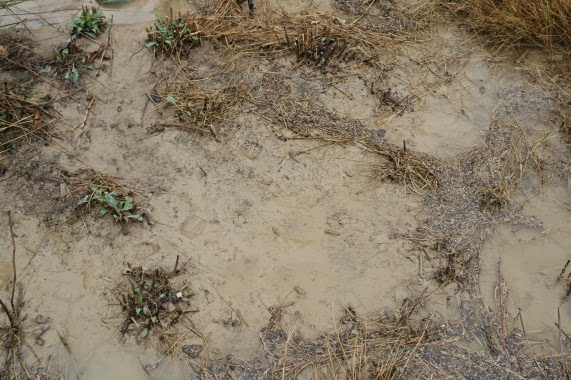Successful Rain Gardens Are Green ALL Season Long!
How does your rain garden function during winter and early spring? Are you starting to see cool season weeds? Is your rain garden managing stormwater runoff and sediment like it does during the lush summer months?
Let's be honest. If a rain garden looks anything like this in winter and early spring, it's not maximizing its function year-round:
When we think of rain garden functionality, we focus our attention on its functionality during the growing season. What we fail to recognize is that it has to function in the dormant season as well. This is a huge problem - not just an offseason aesthetic issue.
Bare soil is one of the main reasons for why rain gardens consistently fail.
Why is bare soil a problem in rain gardens?
Winter precipitation and early spring rains generate larger amounts of stormwater runoff and sediment loads.
Classic rain garden designs simply fail to address this problem. During the dormant season, rain gardens tend to have little to no vegetation to prevent erosion or filter sediments - leading to clogged systems. Equally as important, during the dormant stage, a rain garden's bare soil presents an opportunity for weed invasions.
The solution: Use perennials with evergreen or semi-evergreen basal leaves to offer function and aesthetic value.
Evergreen basal leaves prevent erosion, suppress cool-season weeds, and filter out sediment. This perennial trait is an essential element of successful rain gardens, ensuring proper function beyond establishment and offering soil protection when needed most.
Yes it's true, perennials go winter dormant, but we no longer have to accept bare soil and an empty winter garden. Properly vegetated rain gardens provide the elements we miss most during the cold season: they are green, they have texture, and they are densely vegetated to provide ground cover.
The palette of useful semi-evergreen perennials is vast. We'd love to share our experiences and assist you in choosing proper species with evergreen basal leaves for your next rain garden!
Let's be honest. If a rain garden looks anything like this in winter and early spring, it's not maximizing its function year-round:
 |
| This rain garden's soil is bare and exposed. Silt and sediment washes in and can cause ponding. |
When we think of rain garden functionality, we focus our attention on its functionality during the growing season. What we fail to recognize is that it has to function in the dormant season as well. This is a huge problem - not just an offseason aesthetic issue.
Bare soil is one of the main reasons for why rain gardens consistently fail.
Why is bare soil a problem in rain gardens?
Winter precipitation and early spring rains generate larger amounts of stormwater runoff and sediment loads.
Classic rain garden designs simply fail to address this problem. During the dormant season, rain gardens tend to have little to no vegetation to prevent erosion or filter sediments - leading to clogged systems. Equally as important, during the dormant stage, a rain garden's bare soil presents an opportunity for weed invasions.
The solution: Use perennials with evergreen or semi-evergreen basal leaves to offer function and aesthetic value.
 |
| Carex amphibola |
 |
| Monarda didyma 'Jacob Cline' |
Yes it's true, perennials go winter dormant, but we no longer have to accept bare soil and an empty winter garden. Properly vegetated rain gardens provide the elements we miss most during the cold season: they are green, they have texture, and they are densely vegetated to provide ground cover.
 |
| Deschampsia cespitosa |
The palette of useful semi-evergreen perennials is vast. We'd love to share our experiences and assist you in choosing proper species with evergreen basal leaves for your next rain garden!
 |
| Physostegia virginiana 'Vivid' |



Comments
Post a Comment